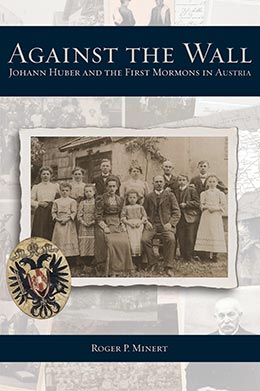Introduction and Prologue
Introduction: The First Latter-day Saints in Austria
In the last fifty years, several attempts have been made to determine precisely who was the first member of The Church of Jesus Christ of Latter-day Saints in Austria. Not only is the answer to this question important in a strictly historical sense, but the establishment of the LDS Church in Austria and its growth there are in part results of the baptisms of the first individuals.
In 1965, the LDS Vienna Austria Stake circulated an account billed as the centennial history of the LDS Church in that country.[1] In 1865, it was still the Kingdom of Austria but would in 1867 become the Austro-Hungarian Empire, often called the Dual Monarchy. The first man to officially preach the restored gospel in that nation was Apostle Orson Pratt, who arrived in that year.[2] He was unsuccessful in winning any converts and returned to London that same year.[3] So ended the Church’s second foray into a Catholic country.[4]
The centennial history claims that the first person baptized in Austria was one Paul Haslinger. His name is indeed featured as the first member of the LDS branch in Rottenbach, Upper Austria, after 1902.[5] He was reportedly baptized in 1883 in Lambach near Bachmanning, where he was born in 1854. This first success was attributed to the work of American missionary Paul Hammer.[6]
Whereas Haslinger was indeed the first Austrian baptized into the Church in Austria, he was actually the second Austrian to be baptized. The first was a woman whose name is listed in the early records of the LDS Munich Branch: Julianna Sulzer had been baptized not in Austria but across the border in Munich, Germany, in 1882 at the age of twenty.[7] We have no way of knowing why she went to Munich from her hometown of Stumm near Innsbruck in the province of Tyrol or how she came into contact with the Church. Nor is there any indication of what became of her—only that “she left the Church on her own volition.”[8]
The third LDS convert in Austria was Maria Mosbacher. Born in 1843 in Mattighofen, Upper Austria, she was baptized in the Munich Branch in 1889. Whatever became of Sister Mosbacher also remains unknown.[9]
The fourth convert in Austria was Martin Ganglmayer, who was born in 1870 in Haag am Hausruck in the province of Upper Austria.[10] The son of a carpenter, he had made his way west to Munich (about 110 miles) to find work, where he came into contact with the Church and was baptized there in 1890. While we have no indication of how long he lived in Munich, it is apparent that he had returned to Haag by 1894, where he reportedly influenced a woman who paradoxically helped lift the LDS faith out of obscurity, but not necessarily in a positive way. In a letter to the Catholic diocesan office in Linz on August 7 of that year, assistant pastor Josef Lang of the Haag Catholic Parish provided this description of a Mrs. Kürner:
A used goods collector named Katharina Kürner lives in our town. When the undersigned arrived here, this old lady, who wears glasses, came to his attention. She came to communion quite often and wrote yours truly very long accounts of the inspiration she had received through visions. She is an extremely abrasive person who lives with another man who is not her husband (who by the way is a better person than she is). Her partner is also married. I tried in vain to advise her, but had to refuse her the holy sacrament and she took that very hard. She considers herself to be enlightened and believes that the [Catholic] Church and its priests are caught up in the world and finances and that only the Mormon prophets can save us. In her attempts to convert people, she has already split up some families. She has even tried to influence the local clergy. Your humble undersigned has tried to have her sent away [Ausweisung], but to no avail. Even the provincial government overturned the city’s ruling because she is a taxpayer and has not been convicted in court.[11]
The diocesan response to Lang’s report was a recommendation that he encourage the woman to give up her errant ways, lest church action be taken against her. Lang was so impressed by the situation that he described it eight years later in similar detail in a letter to the editor of the Oberösterreichische Volkszeitung.[12]
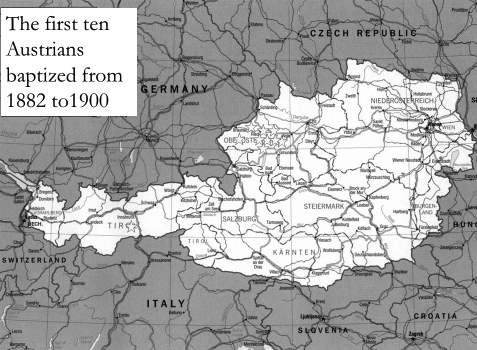 Ten dots identify the location of the hometowns of the first ten Austrians who joined the LDS Church.
Ten dots identify the location of the hometowns of the first ten Austrians who joined the LDS Church.
The records of the Munich Branch show that Frau Kürner was, in fact, baptized there in 1893 as “Barbara Kiener.”[13] She was never again mentioned in the newspaper published in Ried, a county seat in Upper Austria, and was not subsequently listed as a member of the LDS Rottenbach, Austria, Branch.[14] In a second book of Munich Branch records, information devoted to Frau Kiener repeats her personal data and indicates that she emigrated in 1898; her likely goal was Utah. If what Vicar Lang said about her is true, the Mormons first gained some prominence in Upper Austria because of her scurrilous behavior. Officially, Frau Kiener became the fifth Austrian to join the LDS Church.
The sixth convert was Johann Haslinger (unrelated to Paul), also born in Haag in 1840 and baptized in Munich on July 23, 1895. This date is perhaps questionable, because in a 1903 court deposition, recently discovered in the Upper Austrian State Archives in Linz, Haslinger stated, “I withdrew from the Catholic Church and have been a member of the LDS Church since 1899.”[15] A second Munich Branch entry dates his baptism to December 10, 1898. Haslinger, a common street sweeper employed by the town of Haag, married in Altenhof, Upper Austria (about twelve miles north), in 1885 and died in Haag in 1918 at the age of nearly seventy-nine years.[16]
In 1898, two more young Austrian women were baptized in Munich: Magdalena Burya, born in Sankt Johann, Upper Austria, on January 6, 1869, was baptized on August 24. Theresia Fuerboeck, another native of Haag, born on October 15, 1879, was baptized on October 23. Of these two converts, we know only that the latter emigrated (meaning presumably that she went to the United States).[17]
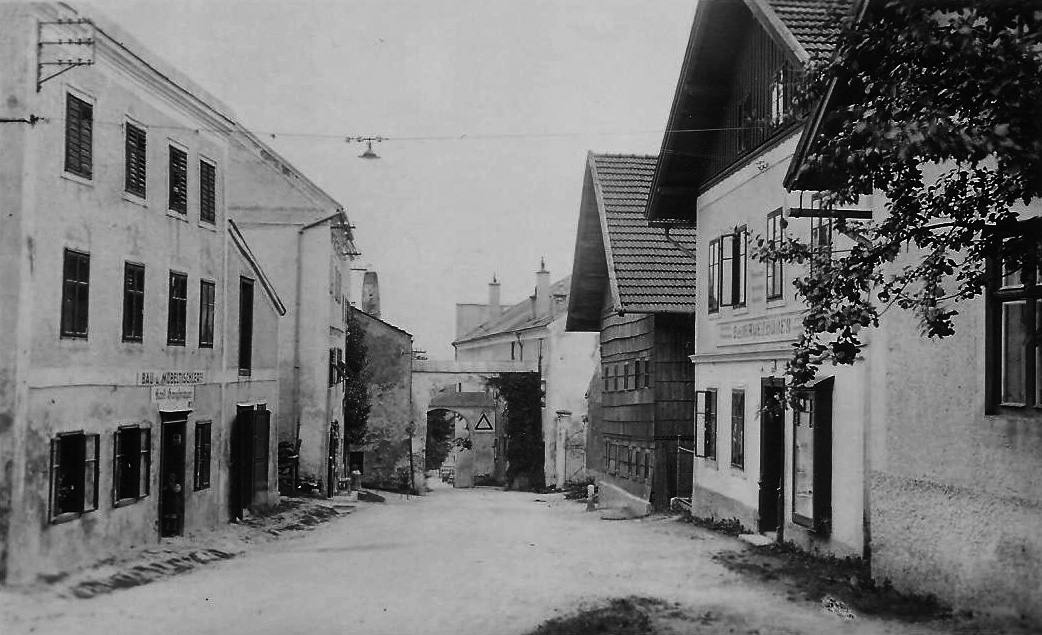 The Ganglmayer home and carpentry shop were situated in the first building on the left side of Haag's main street. Courtesy of Franz Schoberleitner.
The Ganglmayer home and carpentry shop were situated in the first building on the left side of Haag's main street. Courtesy of Franz Schoberleitner.
Yet another Haag native, Josef Zindl, became the ninth Austrian convert. Born on February 17, 1834, he too was baptized in Munich on December 10, 1898. His name is found among the members of the Rottenbach Branch as late as the 1920s.
When he met Mrs. Kiener in the early 1890s, Martin Ganglmayer was a member but not an official representative of the Church. He soon left for Salt Lake City, where he married Swiss immigrant Catharina Leuenberger in 1896. Called to serve in the German Mission in 1899, he was first assigned to the Munich Branch. From that location in southeast Germany, he was only a few hours from his home in Haag, where he visited his parents later that year.[18]
Elder Ganglmayer arrived in his hometown of Haag am Hausruck at precisely the right time to teach the restored gospel to the eventual tenth Austrian convert, Johann Huber.[19] Huber was already embroiled in both religious and political conflicts within his society, and by the end of 1899, he became estranged from his native Catholic faith. Ganglmayer spent a significant amount of time with Huber before leaving for the mission headquarters in Frankfurt am Main, Germany. As is clear from a letter Ganglmayer wrote back to Rottenbach in early 1900, Huber had already decided to be baptized and quickly attracted a good deal of negative local attention.
In 1900, Johann Huber was a controversial political figure in Haag but soon went from the frying pan into the fire when he informed his neighbors of his LDS baptism in Munich on April 21 of that year.[20] For the next decade, Brother Huber weathered continued, relentless persecution from friends, neighbors, Catholic clerics, the local public school, and government officials at city, county, and province levels, including courts in Haag, Ried, Wels, and Linz. Despite attacks from these determined opponents, his stoic fidelity to his adoptive faith resulted in the establishment of an LDS branch in Rottenbach in 1902 and other branches in nearby towns in the years that followed.[21] In 2015, Huber’s descendants number more than 230 and are found in many branches and wards of the LDS Church on two continents.[22]
Of the first ten Austrians baptized into The Church of Jesus Christ of Latter-day Saints, Martin Ganglmayer would play an important role and Johann Huber the lead role in laying the foundation of the Church in that country. Ganglmayer was released from missionary service on January 11, 1902, and returned to his wife in Salt Lake City. From there he moved to Los Angeles in the late 1920s and died there in 1935.
The fifth decade of LDS convert Johann Huber’s long life is remarkable and will be described in great detail on the following pages.
Prologue: A Farm and a Farmer Called Michlmayr
The farm bearing the modern address of Parz 4 in the town of Rottenbach, Austria, has a history that can be documented as early as the year 1379 when it was called der Hof zu Partz.[23] In 1620, a man named Michael Maier inherited the property that soon became known as “Michlmayr.”[24] Over the years, the name was applied to both the farm and its owners.[25] Around 1900, the property measured forty Joch (about fifty-seven acres) and was the largest farm in Parz. The land had the following uses: twenty-seven acres of meadow, twenty-one of plowed fields, and seven acres of forest; there were approximately seventy fruit trees at the time.[26] As the dominant farm in Parz, Michlmayr was about twice as large as any other farm.
To sustain life on the farm, the Hubers had four to six horses and eight to ten cows, not counting foals and calves, and one bull. A goodly number of pigs, chickens, ducks, geese, and sheep were also kept there. Most of the feed was grown on the farm, and small animals were sold or traded for goods and services not produced by the family.[27] As on the farms of their neighbors, self-sufficiency was the goal of the Huber family.
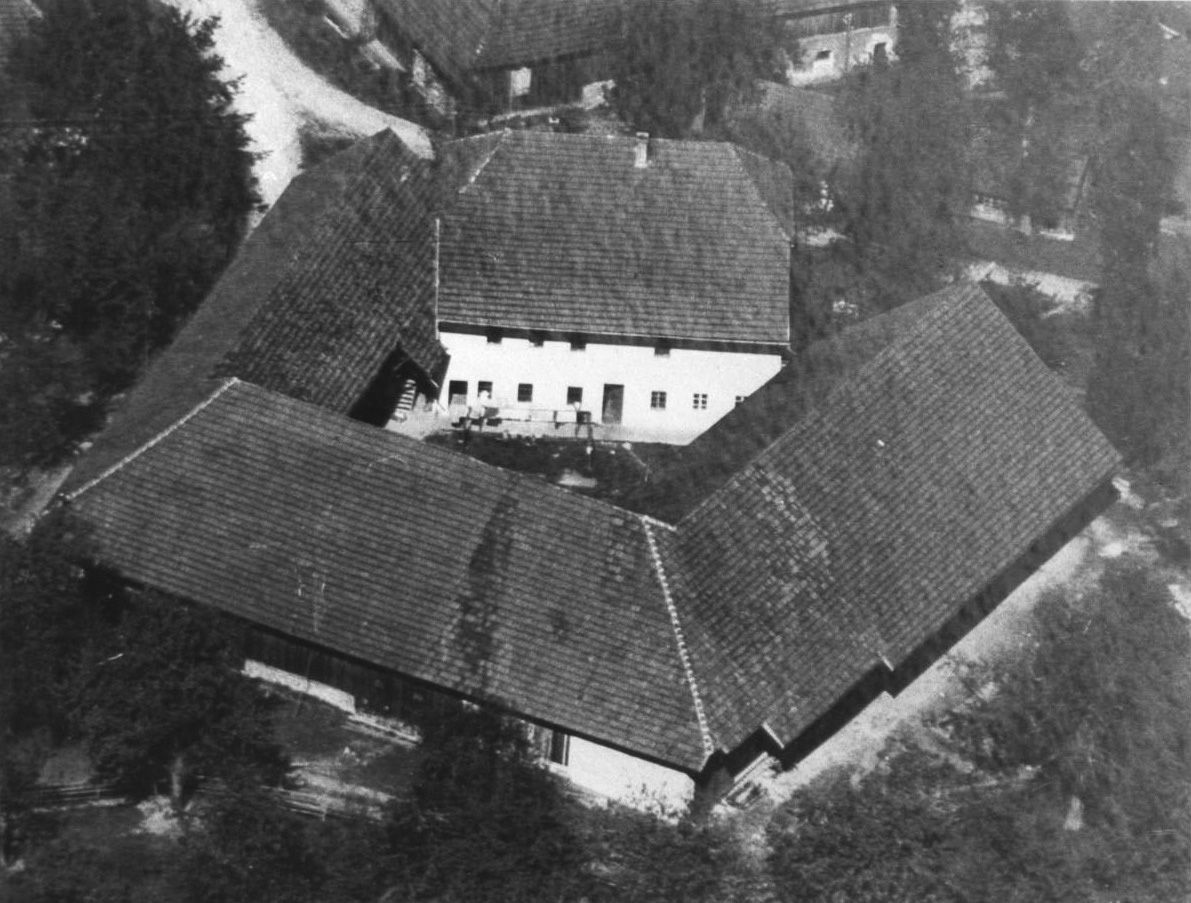 The Michlmayr farm as seen from the air in the mid-twentieth century. Courtersy of Ferlinde Huber Wambacher.
The Michlmayr farm as seen from the air in the mid-twentieth century. Courtersy of Ferlinde Huber Wambacher.
In 1861, Peter Huber was the Michlmayr, and his wife was Franziska née Polz, the great-granddaughter of Peter Polz, born in Rottenbach in 1709. Both the Huber and Polz families had inhabited little towns in the province of Upper Austria for hundreds of years and, like all of their neighbors, were devout Catholics.
Peter and heiress Franziska married in 1854, making Peter Huber the newest Michlmayr. Nine children were born to them on the farm in the fifteen years following their wedding; three of them did not survive infancy. The fifth child, Johann, was born on March 4, 1861, and baptized just hours later in the town’s Catholic parish church under the name Johannes Nepomucemus Huber.[28] He would spend his entire life on the farm with the exception of a term of service in the Austro-Hungarian Imperial Army.
The 1900 government census provides excellent contemporary detail regarding the town of Rottenbach in the province of Upper Austria. The territory comprised 1,463 Hektar (3,613 acres) that included nineteen small neighborhoods with a total population of 1,126 (the Parz neighborhood had 68 inhabitants).[29] They lived in 208 dwellings; all were Catholic with the exception of one Jew. Only one family of noble rank lived in the town at the time. There were no factories in the area, and approximately two-thirds of the territory were plowed acreage in what could be called vintage Austrian farm country. This census did not collect the names of the residents, but it gives more detail than census records in many countries. For example, 145 horses, 1,325 cows, 32 sheep, and 617 pigs were found in Rottenbach in 1900.[30]
At the age of fourteen, Johann Huber was confirmed in the Rottenbach Catholic Church, having completed the required catechism study with other boys and girls his age. At the age of twenty-one he was called to serve the standard term of three years in the Austro-Hungarian army that the law required of every able-bodied man.[31] Unfortunately, enlistment papers of soldiers from Rottenbach have not been preserved, but a photograph taken of Huber in a Wels studio serves as proof of his service in the Imperial and Royal Dragoner Regiment no. 4 stationed in that city.[32]
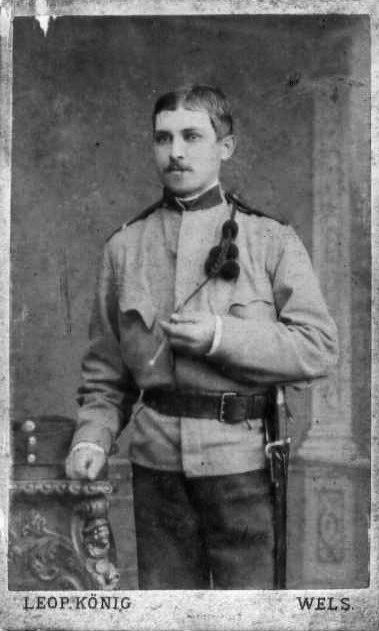 Young Johann Huber in the service of his country in about 1884. Courtesy of Gerlinde Huber Wambacher.
Young Johann Huber in the service of his country in about 1884. Courtesy of Gerlinde Huber Wambacher.
This cavalry regiment had a history reaching back to 1672. Officially renamed the Archduke Albrecht Regiment in 1875, it was commanded by Colonel Karl von Klenek during the years of Johann Huber’s active duty. Fortunately, there were no military conflicts between Austria and any of her several potential enemies, so Huber’s time in Wels would have been uneventful.[33] If he was a typical soldier (and there is no reason to believe that he was anything else), Huber would never have risen above the rank of corporal during his three years of active duty and seven more years in reserve status. In any case, he does not mention his military service in his later correspondence.
Returning to the Michlmayr farm in 1884 and classified as a reserve soldier for the next seven years, Johann took over as his father’s successor. For unknown reasons, his elder brother, Josef (born in 1852), left the farm for employment elsewhere, leaving Johann as the heir.[34] In 1890, he married a Rottenbach native, Theresia Maier. Local custom dictated that nearly every resident in this town of more than one thousand would participate in one aspect or another of the wedding festivities that often lasted as long as one week.
A large estate farm such as Michlmayr needed a substantial team to manage and work it. The desire of every farm owner was to have a large number of children. On farms where this was not the case, young single and temporary employees were engaged to carry out labor not done by family members. Johann and Theresia were likely pleased to see their family grow to include twelve children by 1908, all but three of whom lived to adulthood. Nevertheless, family tradition has it that four to six laborers worked at the farm at any time during those years.
As the year 1899 approached, life in general was good in Austria and at Parz 4 in Rottenbach in particular. However, before the year was over, Huber family life was changed forever. The controversy that erupted that year and lasted for a decade cost Johann Huber a great deal of time and money. The ownership of this large estate enabled him to survive financially.
Notes
[1] Austrian Mission, “History of the Mormons in Austria, 1865–1965” (Vienna: LDS Austrian Mission, 1965).
[2] Heinrich Marion Teply wrote that LDS Apostle Orson Hyde preached the gospel in Vienna in 1841 as part of his journey to the Holy Land. Heinrich Marion Teply, Das Licht Scheint in der Finsternis Geschichte der Kirche Jesu Christi der Heiligen der Letzten Tage in Osterreich, L. Tom Perry Special Collections, Harold B. Lee Library, Brigham Young University, Provo, UT (ca. 1994). However, since little is known of his activities there at the time, it is no wonder that the Vienna LDS authors chose 1865 as their centennial date.
[3]“History of the Mormons in Austria,” 6.
[4] Lorenzo Snow was sent to Italy as a missionary and arrived in July 1850. The missionary effort in that country lasted only a few months. Eliza R. Snow Smith, Biography and Family Record of Lorenzo Snow (Salt Lake City: Deseret News, 1884), 117.
[5] Record of Members, LDS Rottenbach Branch, Rottenbach, Austria, microfilm 38866, Family History Library, Salt Lake City.
[6] Manuscript History and Historical Reports, Austria Vienna Mission, LR 10876 2, Church History Library, Salt Lake City.
[7] Record of Members, LDS Munich Branch, Munich, Germany, microfilm 68801, Family History Library.
[8] Record of Members, LDS Munich Branch (Munich, Germany), microfilm 68801, Family History Library.
[9] Record of Members, LDS Munich Branch, Munich, Germany, microfilm 68801, book 1 (1869–98), Family History Library. In addition, a search of the new.familysearch database shows that no LDS vicarious temple ordinances have been conducted in her behalf. A search of the Mattighofen birth records for the year 1843 failed to identify any child named Maria. Mattighofen Catholic Parish to Roger P. Minert, e-mail, July 13, 2013.
[10] The Upper Austrian towns of Rottenbach and Haag are less than two miles apart. The residents of Rottenbach did much of their business in the market town of Haag; thus people in those two towns were well acquainted with each other.
[11] Josef Lang to Linz Diocesan Office, August 7, 1894, Diözesanarchiv Linz, CA/
[12] Oberösterreichische Volkszeitung (Linz, Austria), June 13, 1902. Lang’s story is yet another corroboration that Haslinger was not baptized in Lambach in 1883.
[13] Record of Members, LDS Munich Branch.
[14] Her maiden name has yet to be identified.
[15] Johann Haslinger to Ried County Office, January 20, 1903, Oberösterreichisches Landesarchiv, BH Ried XI E 1903.
[16] Haslinger marriage in Altenhof, August 10, 1885, death records book 4:147, Haag Catholic Parish (Haag, Austria). Online images of parish records can be found at http://
[17] Record of Members, LDS Munich Branch, book 1 (1869–98).
[18] There were still no missionaries residing in Austria at that time or anywhere within the Austro-Hungarian Empire.
[19] Teply suggested that Huber and Ganglmayer were friends in their youth, but this can hardly have been the case given the difference in their ages (nine years) and that they grew up and attended school in different towns. Teply, Das Licht Scheint in der Finsternis, 49.
[20] Record of Members, LDS Munich Branch, book 2 (1898–1900).
[21] The Rottenbach Branch held its meetings on the Huber farm for two decades.
[22] Genealogical information provided by Eric Hirschmann of Orem, Utah.
[23] Gerlinde Huber Wambacher to Roger P. Minert, July 30, 2014.
[24] No attempt will be made to point out the numerous spelling variations of this name as found in many documents and newspapers. Even Johann Huber spelled the name in several different ways.
[25] Parz is the southernmost neighborhood of Rottenbach. In those days, streets in Austrian towns had no names. Houses were numbered throughout the town, each new house receiving the next higher number.
[26] Gerlinde Huber Wambacher to Roger P. Minert, September 5, 2014. One joch is equivalent to forty square klafters (about eighty-three yards) on a side. This comes to 0.5755 hectare or about 1.422 acres. http://
[27] Gerlinde Huber Wambacher to Roger P. Minert, July 30, 2014.
[28] The second given name was not used for any other purpose in this man’s life.
[29] K. K. Statistische Zentralkommission, Gemeindelexikon der im Reichsrate vertretenen Königreiche und Länder, II Oberösterreich (Vienna: K. K. Hof- und Staatsdruckerei, 1853), 116–17.
[30] K. K. Statistische Zentralkommission, Gemeindelexikon der im Reichsrate vertretenen Königreiche und Länder, II Oberösterreich, 116–17.
[31] Steven W. Blodgett, “Great-Grandfather Was in the Imperial Cavalry: Using Austrian Military Records as an Aid to Writing Family History” (Salt Lake City: Corporation of the President, 1980).
[32] Karin Bachschweller to Roger P. Minert, October 2, 2014.
[33] http://
[34] This is especially curious due to the fact that Peter Huber died in 1866. His widow never remarried and died on the farm in 1908. Josef returned to the farm during the first days of the Church’s presence there.
